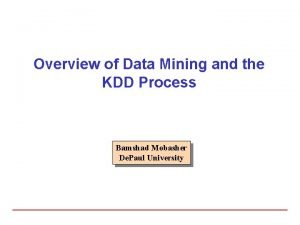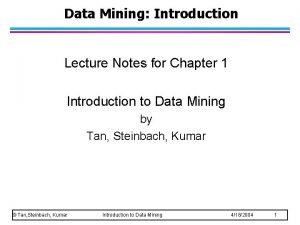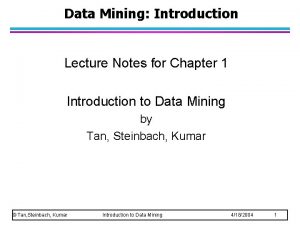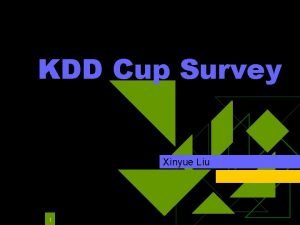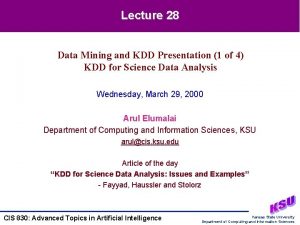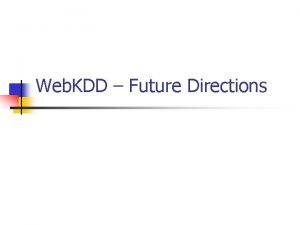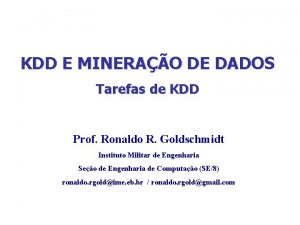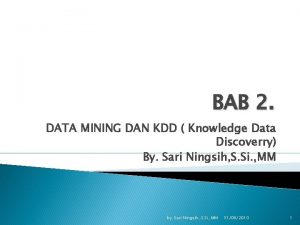Lecture 30 Data Mining and KDD Presentation 2

















- Slides: 17

Lecture 30 Data Mining and KDD Presentation (2 of 4): Relevance Determination in KDD Monday, April 3, 2000 Ding. Bing Yang Department of Plant Pathology, KSU Read: “ Irrelevant Features and the Subset Selection Problem” George H, John; Ron Kohavi; Karl Pfleger CIS 830: Advanced Topics in Artificial Intelligence Kansas State University Department of Computing and Information Sciences

Presentation Outline • Objective – Finding a subset of features that allows a supervised induction algorithm to induce small high-accuracy concepts • Overview – Introduction – Relevance Definition – The Filter Model and The Wrapper model – Experimental results • References – Selection of Relevant Features and Examples in Machine Learning: Avrim L. Blum, Pat Langley. Artificial Intelligence 97(1997) 245 -271 – Wrappers for Feature Subset Selection: Ron Kohavi, Geoge H. John. Artificial Intelligence 97(1997) 273 -324 CIS 830: Advanced Topics in Artificial Intelligence Kansas State University Department of Computing and Information Sciences

Introduction • Why find a good feature subset ? – – • • Some learning algorithm degrade in performance ( prediction accuracy) when faced with many features that are not necessary for predicting the desired output. Decision tree algorithm : ID 3, C 4. 5, CART; Instance-based algorithm : IBL Some algorithm are robust with respect to irrelevant features, but their performance may degrade quickly if correlated features are added, even if the features are relevant Naïve-Bayes An example – – running C 4. 5, Dataset is Monk 1, there are 3 irrelevant features. The induced tree has 15 interior nodes, five of them test irrelevant features, – the generated tree has an error rate of 24. 3% if only the relevant features are given, the error rate is reduced to 11. 1% What is a optimal feature subset? – Given an inducer I, and a dataset D with features X 1, X 2, … Xn, from a distribution D over the labeled instance space. An optimal feature subset is a subset of the features such that the accuracy of the induced classifier C=I(D) is maximal. CIS 830: Advanced Topics in Artificial Intelligence Kansas State University Department of Computing and Information Sciences

Incorrect Induced Decision Tree Correlated 1 0 A 1 0 0 0 0 Irrelevant A 0 1 0 1 1 The tree induced by C 4. 5 for “Corral” dataset that has “correlated” features and irrelevant features CIS 830: Advanced Topics in Artificial Intelligence Kansas State University Department of Computing and Information Sciences

Background Knowledge – ID 3 algorithm • It is a decision tree learning algorithm. It constructs decision tree top-down. • Compute the information gain of each instance attribute among the candidate attributes. Select the attribute that has maximum IG value as the test at the root node of the tree. • The entire process is then repeated using the training example associated with each descendant node. – C 4. 5 algorithm • It is a improvement over ID 3. It is a rule post-pruning. • Infer the decision tree from the training set. Convert the learned tree into an equivalent set of rules. • Prune each rule by removing any precondition that result in improving its estimated accuracy. CIS 830: Advanced Topics in Artificial Intelligence Kansas State University Department of Computing and Information Sciences

Background Knowledge – K-Nearest neighbor Learning • It is a instance-based learning. It just simply stores the training examples. Generalization beyond these examples is postponed until a new instance must be classified. • Each time a new query instance is encountered, its relation to the previous stored examples is examined. • The target function value for a new query is estimated from the known values of the k nearest training examples. – Minimum Description Length (MDL) Principle • Choosing the hypothesis that minimizes the description length of the hypothesis plus the description length of the data given the hypothesis. – Naïve Bayes classifier • It incorporates the simplifying assumption that attributes values are conditionally independent, given the classification of the instance. CIS 830: Advanced Topics in Artificial Intelligence Kansas State University Department of Computing and Information Sciences

Relevance Definition • Assumption • a set of n training instances are tuple <X, Y>. X is an element of the set F 1 x. F 2 x…x. Fm. Fi is the domain of the ith feature. Y is label. • Given an instance, the value of feature Xi is denoted by xi. • Assume a probability measure p on the space F 1 x. F 2 x…x. Fm x. Y. • Si is the set of all features except Xi. Si={X 1, …Xi-1, Xi+1, …, Xm}. • Strong relevance • Xi is strongly relevant iff there exists some xi, y and si for which p(Xi = xi, Si= si ) >0 such that p(Y=y | Si= si , Xi = xi) p(Y=y | Si= si ) • Intuitive understanding: the strongly relevant feature can’t be removed without loss of prediction accuracy • CIS 830: Advanced Topics in Artificial Intelligence Kansas State University Department of Computing and Information Sciences

Relevance Definition • Weak Relevance • A feature Xi is weakly relevant iff it is not strongly relevant, and there exists a subset of features Si’ of Si for which there exists some xi, y and si for which p(Xi = xi, S’i= s’i ) >0 such that p(Y=y | S’i= s’i , Xi = xi) p(Y=y | S’i= s’i ) • Intuitive understanding: The weakly relevant feature can sometimes contribute to prediction accuracy. • Irrelevance • features are irrelevant if they are neither strongly nor weakly relevant. • Intuitive understanding: Irrelevant features can never contribute to prediction accuracy. • Example • Let features X 1, …X 5 be Boolean. X 2= ¬X 4 , X 3=¬X 5. There are only eight possible instance, and we assume they are equiprobable. Y = X 1 + X 2 weakly relevant ; X 3, X 5: irrelevant • X 1: strongly relevant; X 2, X 4: CIS 830: Advanced Topics in Artificial Intelligence Kansas State University Department of Computing and Information Sciences

Feature Selection Algorithm • A heuristic search – Heuristic search: • each state in the search space specifies a subset of the possible features. • Each operator represents the addition or deletion of a feature – The four basic issues in the heuristic search process. • Starting point : – forward selection, backward elimination, both of them. • Search organization: – exhaustive search, greedy search, best-first search. • Evaluate function: – prediction accuracy, structure size, induction algorithm • Halting criterion: – – when none of alternatives improves the prediction accuracy – until the other end of the search and then select the best The type of heuristic search: Filter model and Wrapper model CIS 830: Advanced Topics in Artificial Intelligence Kansas State University Department of Computing and Information Sciences

Heuristic Search Space The state space search for feature subset selection 1. all the states in the space are partially ordered. 2. each of a state’s children includes one more attribute. CIS 830: Advanced Topics in Artificial Intelligence Kansas State University Department of Computing and Information Sciences

Feature Subset Selection Algorithm Input features Feature subset selection Induction algorithm Filter Model Feature subset search Input features Feature subset evaluation Induction algorithm Wrapper Model CIS 830: Advanced Topics in Artificial Intelligence Kansas State University Department of Computing and Information Sciences

Filter Approach • Filter approach – FOCUS algorithm (min-features) • exhaustively examines all subsets of features • select the minimal subset of features that is sufficient to determine the label • problem: Sometimes the resulting induced concept is meanless. – Relief algorithm • assign a relevant weight to each feature, which represent the relevance of the feature to the target concept. • It samples instances randomly from the training set and updates the relevance values based on the difference between the selected instance and the two nearest instances of the same and opposite class. • Problem: can’t remove many weakly relevant features. – Cardie algorithm • use a decision tree algorithm to select a subset of features for a nearestneighbor algorithm. • Example If I (A; C) > I (A; D) > I (A; B) CIS 830: Advanced Topics in Artificial Intelligence Kansas State University Department of Computing and Information Sciences

Filter Approach Totally irrelevant features Relief Focus Weakly relevant features Strongly relevant features Relationship of filter approach and feature relevance • FOCUS: all strong relevances and part of weak relevances. • Relief: both strong relevances and weak relevances. CIS 830: Advanced Topics in Artificial Intelligence Kansas State University Department of Computing and Information Sciences

Wrapper Approach • A wrapper search use the induction algorithm as a black box. – Using the induction algorithm itself as part of the evaluation function. – A search requires a state space, an initial state, a termination condition, and a search engine. • Each state represents a feature subset. • Operators determine the connectivity between the states. For example: operators that add or delete a single feature from a state. • The size of the search space for n features is O(2 n). • The goal of the search: find the state with the highest evaluation, using a heuristic function to guide it. • Subset Evaluation: Cross-validation (n-fold): • The training data is split into n approximately equally sized partitions. • The induction algorithm is then run n times, each time using n-1 partitions as the training set and the other partition as the test set. • The accuracy results from each of the n runs are averaged to produce the estimated accuracy. CIS 830: Advanced Topics in Artificial Intelligence Kansas State University Department of Computing and Information Sciences

Wrapper Approach Feature Subset Training Set 1 2 3 1 2 1 3 Train Induction Test c Eval 3 Eval Induction c Avg 2 Eval 2 3 Induction c 1 Cross Validation (3 -fold) CIS 830: Advanced Topics in Artificial Intelligence Kansas State University Department of Computing and Information Sciences

Experimental Evaluation • Datasets – Artificial datasets: Corr. AL, Monk 1*, Monk 3*, Parity 5+5 – Real-world datasets: Vote, Credit, Labor • Induction algorithm – ID 3 and C 4. 5 • Feature subset selection approach – wrapper approach • Cross validation – 25 -fold • results – The main advantage of doing subset selection is that smaller structures are created. – Feature subset selection using the wrapper model did not significantly change generalization performance. – When the data has redundant feature, but also has many missing values, the algorithm induced a hypothesis which makes use of these redundant features. – Induction algorithms have a great influences on the performance of the FSS approach. CIS 830: Advanced Topics in Artificial Intelligence Kansas State University Department of Computing and Information Sciences

Summary Content Critique • Key Contribution - It presents a feature-subset-selection algorithm that depends on not only the features and the target concept, but also on the induction algorithm. • Strengths – It differentiates irrelevance, strong and weak relevance. – The wrapper approach works better on correlated features and irrelevant features. – Smaller structures are created. smaller trees allow better understanding of the domain. – Significant performance improvement is achieved on some datasets. (the error rate reduced) ° Weaknesses – Its computational cost is expensive. Calling the induction algorithm repeatedly – Overfitting. Overuse of the accuracy estimates in the feature subset selection. – Experiment only on the decision tree algorithm (ID 3, C 4. 5). How about other learning algorithms (Naïve Bayesian classifier). – The performance is not always improved, just on some datasets. º Audiences: AI researchers and expert system researchers in all kinds of field. CIS 830: Advanced Topics in Artificial Intelligence Kansas State University Department of Computing and Information Sciences
 What is kdd process in data mining
What is kdd process in data mining Kdd process
Kdd process Eck
Eck Mining multimedia databases
Mining multimedia databases Bayesian classification in data mining lecture notes
Bayesian classification in data mining lecture notes Data mining lecture notes
Data mining lecture notes Data mining lecture notes
Data mining lecture notes Data mining lecture notes
Data mining lecture notes Difference between strip mining and open pit mining
Difference between strip mining and open pit mining Difference between text mining and web mining
Difference between text mining and web mining Olap data mart
Olap data mart Olap database
Olap database Introduction to data warehousing and data mining
Introduction to data warehousing and data mining Strip mining vs open pit mining
Strip mining vs open pit mining Mineral resources and mining chapter 13
Mineral resources and mining chapter 13 Kdd cup 1998 solution
Kdd cup 1998 solution Yüksek frekanslı akımların özellikleri
Yüksek frekanslı akımların özellikleri Kdd task manager
Kdd task manager

